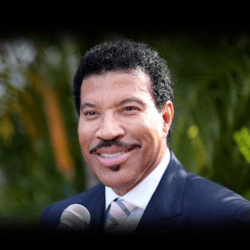Lionel Richie | Bio, Age, Net Worth, Life Style, And Many More
American popular singer, songwriter, and producer Lionel Richie, full name Lionel Brockman Richie, Jr., was born in Tuskegee, Alabama, on June 20, 1949. He is best known for his smooth and soulful love ballads from the 1970s and ’80s. He was a very proficient musician who could recreate many additional musical genres, soul, cadence, and blues, most notably funk, and government.
Richie was born into a musically accomplished family. His mother was a teacher who thereafter maintained the Place of the school principal, and his daddy performed as a techniques reviewer for the U.S. Army. Richie spent the majority of his childhood living practically on the grounds of the storied Tuskegee Institute (now Tuskegee University), in the house of his maternal grandparents.
His grandmother was a classical pianist, and it was through her that he first learned about the principles of music and the great classical composers. His first saxophone was a gift from his uncle, a large band jazz performer and arranger. Richie first gravitated towards gospel music, largely due to his interest in pursuing a career as a preacher, but he quickly absorbed musical influences from numerous African American popular styles as well as from country music, which was prevalent in the American South.
When he was younger, Richie relocated to Illinois with his family and attended Joliet East High School. He went to Alabama to attend the Tuskegee Institute to study economics and accounting after graduating in 1967. He joined the Mystics, a campus band, during his first year as a saxophonist, songwriter, and occasionally singer. The Mystics, with Richie as lead vocalist, evolved into the funk and rhythm-and-blues group the Commodores in 1968 after some personnel changes.
The Commodores used their summer study vacation to look into performance chances in New York City, buoyed by the size of their local fan base. When they arrived in the city, an agent picked them up and made reservations for them in several reputable nightclubs; the next summer, they started a European tour. A Motown Record Corporation executive saw the group during one of their concerts, and he made arrangements for them to open for the American tour of pop music sensation the Jackson 5 in 1971. The Commodores entered the mainstream after that encounter.
The Commodores inscribed with the Motown brand in 1974, the exact year Richie acquired his bachelor’s grade in economics from the Tuskegee Institute. But it wasn’t until 1978 that the band released “Three Times a Lady,” a waltz-timed melancholy ballad that peaked at number one on the Billboard Hot 100. Richie composed and performed the song after being moved by the celebration of his parents’ 37th wedding anniversary. Richie’s anthem of love, “Still,” brought the trio yet another number one success in 1979. The Commodores were mostly supported by Richie’s ballads, which frequently blended instrumental elements of country music with melodies and rhythm and blues beats. They also released a few moderately successful funk songs.
Richie’s diverse musical abilities led to collaborations with other musicians. He composed and produced “Lady” for country musician Kenny Rogers in 1980 and “Endless Love” with pop-soul singer Diana Ross in 1981. Such artistic forays expedited Richie’s meteoric ascent to fame and ultimately led to his breakup with the Commodores. Richie’s solo career officially began in 1982 with the release of his album Lionel Richie.
The following few years were a whirlwind, with the release of numerous number one singles, such as the latin-tinged dance song “All Night Long (All Night)” (1983) and the lyrical love songs “Hello” (1984) and “Say You, Say Me” (1985), as well as two additional albums, Can’t Slow Down (1983) and Dancing on the Ceiling (1986). Can’t Slow Down was one of Motown’s best-selling albums and not only won the Grammy Award for album of the year. In order to collect money for famine relief in Africa, Richie and Michael Jackson collaborated on the song “We Are the World” in 1985. The song was nominated for a Grammy for song of the year and raised about $50 million in donations.
Richie’s output decreased with the success of Can’t Slow Down and Dancing on the Ceiling. Before he made his subsequent studio album, Louder than Words (1996), a stylistically modernised fusion of soft jazz, rhythm and blues, and hip-hop, ten years had gone. Although a commercial success, Richie’s album received a less enthusiastic reception than his earlier releases. The reception to his albums was largely unimpressive during the following 15 years.
Tuskegee, a collection of Richie’s best hits performed with Shania Twain, Tim McGraw, Rascal Flatts, Willie Nelson, and other country music greats, propelled him back into the public eye in 2012. The album quickly rose to the top of the Billboard Top 200 and Country Music charts, eventually ranking among the best-selling albums of the year. Following a global tour from 2013 to 2015, Richie debuted a residency in Las Vegas in 2016. He joined country musician Luke Bryan and pop singer Katy Perry as judges on the return of the American Idol singing competition two years later.
Richie’s other distinctions, outside his Grammy Awards, include his 1994 entry into the Songwriters Hall of Fame. In 2017, he was also awarded a Kennedy Centre Honour. He was chosen for inclusion into the Rock and Roll Hall of Fame five years later.





